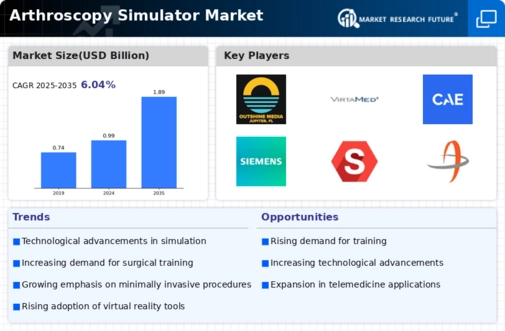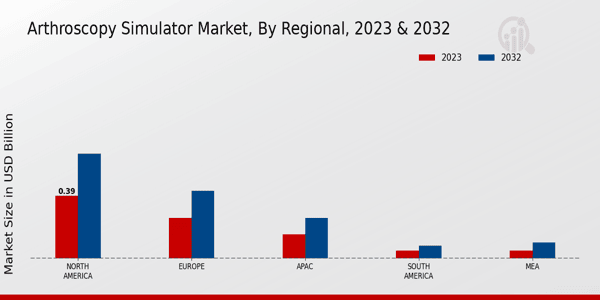Market Growth Visualization
Rising Incidence of Joint Disorders
The Global Arthroscopy Simulator Market Industry is significantly influenced by the rising incidence of joint disorders, including osteoarthritis and sports-related injuries. As the global population ages and participation in sports increases, the demand for arthroscopic surgeries is likely to rise. This trend necessitates the training of a skilled workforce capable of performing these procedures effectively. Consequently, the market for arthroscopy simulators is expected to expand, with projections indicating a market size of 1.89 USD Billion by 2035. This growth underscores the importance of simulation training in preparing surgeons to meet the increasing surgical demands.
Expansion of Healthcare Infrastructure
The Global Arthroscopy Simulator Market Industry benefits from the ongoing expansion of healthcare infrastructure across various regions. As countries invest in improving healthcare facilities and services, the availability of advanced training tools, including arthroscopy simulators, becomes more widespread. This expansion is particularly evident in developing nations, where the establishment of new medical centers and training institutions fosters the adoption of innovative surgical training methods. The resulting increase in the number of trained surgeons is likely to drive the demand for arthroscopy simulators, contributing to the overall growth of the market.
Growing Focus on Surgical Training and Education
The Global Arthroscopy Simulator Market Industry is propelled by an increasing emphasis on surgical training and education. Medical institutions are recognizing the importance of simulation-based training to enhance the skills of aspiring surgeons. This shift towards competency-based education necessitates the integration of arthroscopy simulators into training programs. By providing a safe environment for practice, these simulators allow trainees to hone their skills without risking patient safety. As educational institutions invest in advanced training technologies, the market is poised for growth, aligning with the projected increase in demand for skilled arthroscopic surgeons.
Increasing Demand for Minimally Invasive Procedures
The Global Arthroscopy Simulator Market Industry experiences heightened demand due to the growing preference for minimally invasive surgical techniques. These procedures are associated with reduced recovery times, lower risk of complications, and minimal scarring. As healthcare providers increasingly adopt these techniques, the need for effective training tools, such as arthroscopy simulators, becomes paramount. The market is projected to reach 0.99 USD Billion in 2024, reflecting this trend. Furthermore, as surgical training evolves, the integration of simulators into curricula is likely to enhance the proficiency of surgeons, thereby driving market growth.
Technological Advancements in Simulation Technology
Technological innovations play a crucial role in shaping the Global Arthroscopy Simulator Market Industry. The development of high-fidelity simulators that replicate real surgical scenarios enhances the training experience for medical professionals. Features such as haptic feedback, virtual reality, and augmented reality are increasingly incorporated into simulators, providing realistic and immersive training environments. These advancements not only improve surgical skills but also contribute to better patient outcomes. As the market evolves, the anticipated growth rate of 6.04% CAGR from 2025 to 2035 indicates a robust future for technologically advanced arthroscopy simulators.




















